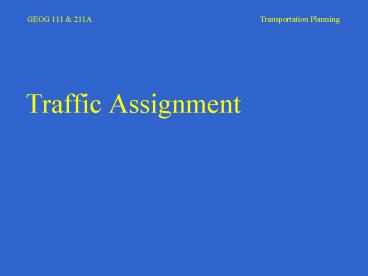Traffic Assignment PowerPoint PPT Presentation
1 / 24
Title: Traffic Assignment
1
Traffic Assignment
2
Traffic Assignment
- Fourth Step in UTPS Modeling
- Inputs
- Peak Hour, Passenger Vehicle Origin - Destination
(O - D) Matrix - Network
- Travel Time, Capacity, Direction
- Outputs
- Peak Hour Volumes, Estimated Travel Times, and
Volume to Capacity Ratios
3
Key Ingredients
- Link performance functions (travel time vs
traffic volume) - Turning delays (penalties)
- Algorithm for assignment of traffic
- Behavioral assumptions
4
Key Objectives
- Obtain aggregate network measures
- Estimate zone-to-zone travel times (costs)
- Obtain link flows
- Estimate routes for each O-D pair
- Analyze O-D pairs
- Obtain turning movements
5
Link Performance Functions
- Mathematical Relationship Between Traffic Flow
and Travel Time
Linear Relationship
Non-Linear Relationship
Route Travel Time
Capacity
Free-Flow Travel Time
Traffic Flow
Traffic Flow
6
Example (BPR formula)
Vvolume, Ccapacity, t0free flow travel time
7
Example (BPR formula)
Vvolume, Ccapacity, t0free flow travel time
8
Key Ingredients
- Link performance functions (travel time vs
traffic volume) - Turning delays (penalties)
- Algorithm for assignment of traffic
- Behavioral assumptions
9
Types of Penalties
- TURNING At intersections for turning left,
right or through - TRANSITION Transition between two different
types of highways (on-ramp, off-ramp movements) - TRANSFER Inter(multi)modal interchanges
(waiting time at bus stop)
BPR
BPR
BPR
BPR
10
Key Ingredients
- Link performance functions (travel time vs
traffic volume) - Turning delays (penalties)
- Algorithm for assignment of traffic
- Behavioral assumptions
11
Algorithms
- Uncongested vs Congested Networks (capacity)
- Deterministic vs Stochastic (analysts ignorance
and peoples heterogeneity) - With vs Without Traffic Control feedback (think
of intersections control effects) - Treatment of time equilibrium considerations
- Combined with other steps
12
Comparison
Stochastic effects included? No Yes Stochastic effects included? No Yes
Is capacity restraint included? No All-or-Nothing Pure stochastic Dials, Burrells
Is capacity restraint included? Yes Wardrops equilibrium Stochastic user equilibrium
13
Basic Assignment Methods (in TRANSCAD)
- All or Nothing
- STOCH
- Incremental
- Capacity Restraint
- User Equilibrium
- Stochastic User Equilibrium
- System Optimum
14
All or Nothing Assignment
- Assumption
- All drivers consider the same attributes for
route choice perceive and weigh them in the same
way - All traffic is assigned to shortest path between
each O-D pair - No congestion effect
- Link costs are fixed
- Simple, but not accurate
15
All or Nothing Assignment
- All traffic from zone i to zone j uses the
(initially) minimal travel time path - Roadway performance NOT enforced during
assignment - May Become Inaccurate, but simple fast method
- NOT for congested networks
16
STOCH (Transcad)
- Based on choice probability for each path from an
origin to a destination - In a path TRANSCAD considers only reasonable
links links that take a traveler away from
origin and closer to destination - Link travel time not dependent on link volume
- Probability based on LOGIT (reviewed in modal
choice) - Traveler chooses the most convenient path
17
Incremental Assignment
- Many steps in the procedure
- In each step one fraction of OD matrix assigned
using all-or-nothing assignment - At each step link travel times are based on the
volume assigned in previous step - May become very inaccurate
18
Capacity Restraint
- Many steps in the procedure
- All-or-Nothing and then compute travel times
- All-or-Nothing using new travel times based on
link performance (get new travel times) - All-or-Nothing using latest travel times
- Algorithm may flip-flop
19
User Equilibrium
- Assignment is performed such that travel time
from zone i to zone j cannot be decreased by
using an alternate route - Minimal time path used until congestion effects
make an alternate path have the same travel time,
both used until congestion effects make another
alternate path have the same travel time and so
on - Roadway performance enforced
- Long, iterative process
20
UE both paths same travel time
Path 1 Cost
Path 2 Cost
Trips on Path 2
Trips on Path 1
21
Stochastic User Equilibrium
- Similar to User Equilibrium, with error term
introduced in determining shortest path - Paths with best travel time used by more vehicles
- Less attractive paths used by less vehicles
- More realistic behavior
22
System Optimum
- Minimizes TOTAL travel time
- Minimal travel time path for specific OD pairs
not necessarily used - Think of an application for UPS
- Roadway performance (travel time function of
travel volume used)
23
Other Issues
- Combining private car, transit, and trucks
- Regional applications vs Statewide applications
- Data quality and potential failures
- Dynamic traffic assignment and related algorithms
(see the site http//www.mti.umd.edu/research/rec
entResearch.htm)
24
Exam Notes
- Why, when, and how of transportation planning
- Policy-planning-programming
- Geo-hierarchy and temporal hierarchy of plans
- Travel surveys and the total design method
- Types of surveys and ways to communicate with
people - Air quality/emissions
- Travel model and the four step procedures
- Trip generation models
- Trip distribution models
- Mode Choice
- Traffic assignment procedures
- Input to each and output from each step
- Regression models and why
- Mostly conceptual but bring calculator just in
case

